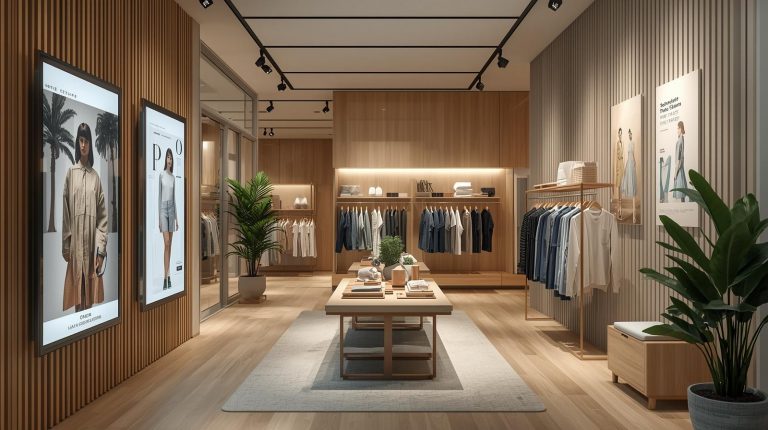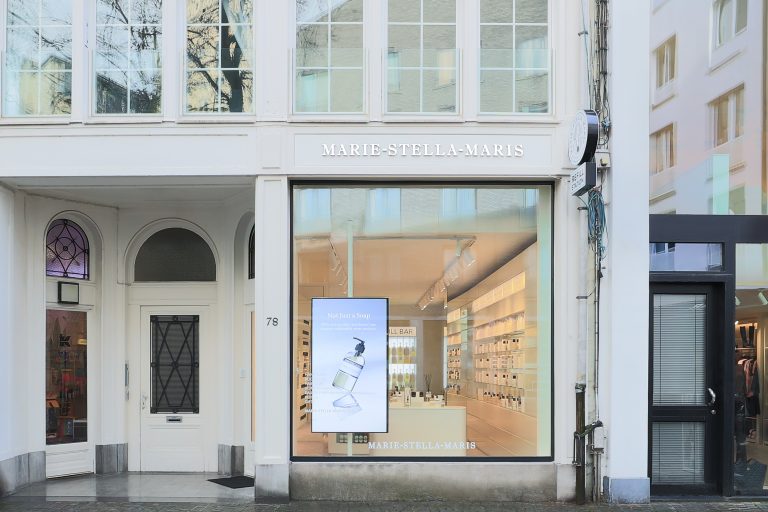Retailers are investing in sustainability: electric delivery vans, green energy, circular packaging. But what about those stacks of posters that are replaced every two weeks? Nobody thinks about them. What was once invisible is now proving to be the perfect low-hanging fruit for your sustainability goals.
In this article, you’ll discover why paper posters have a hidden environmental impact, how digital signage solves this problem, and how you can make the switch in three steps without high costs.
By Kjeld Veenhuis, Account manager & Sustainability specialist
As an account manager involved in BRIX Zero – the first fully carbon-neutral and circular digital signage solution in the Netherlands – I often see that visual merchandising is a major blind spot in retail sustainability policies.

In this article, I’ll show you:
- Why paper posters are your biggest blind spot
- The surprising parallel between sustainability in other sectors and visual merchandising in retail
- A practical 3-step plan to switch from paper to digital
After reading this article, you will know exactly how to make your visual merchandising as sustainable as the rest of your business operations, without any hassle or high investments.
An eye-opener at a ‘sustainable’ fashion chain
This summer, I had a conversation with the sustainability manager of a fashion chain with 18 shops. She proudly began talking about their sustainability certificate. Green energy, circular packaging, paperless administration.
“We are real leaders in sustainability,” she said. “Just look at our figures – we score above the sector average.”
As we walked through the store, my eye was caught by the large posters on display. Beautiful images of the new collection.
“How often do you replace these?” I asked.
“Every few weeks. Isn’t that standard?”
Silence, and then the realisation hit.
‘We’ve never really thought about that.’

Why retailers have already become much more sustainable – except for their posters
This retailer is no exception. Most retailers have already taken significant steps:
- Circular packaging is the new norm. FSC-certified, recycled materials, reusable bags. It’s all part of the package.
- Green energy and LED lighting. Solar panels on the roof, energy-efficient lighting in the stores. Standard in new buildings.
- Electric vehicle fleet for distribution. Transport is minimised, electric vans for the last few kilometres.
- Paperless administration. Digital first in back office, e-receipts, no more unnecessary printing.
- Transparency about the production chain. More and more brands are using QR codes on labels that show the entire chain from raw material to garment.
But what about those posters and prints in the stores? They are still printed every few weeks, sent to all stores, displayed and replaced weeks later. Because “that’s how it’s always been done”.

Why visual merchandising is often overlooked in sustainability efforts
The same retailers who have made their entire chain more sustainable still have stores full of paper posters that are replaced regularly. No one questions the impact of all that paper, transport and waste processing.
- Scope 3 emissions that are completely overlooked.
You know exactly where your packaging material comes from, but do you have any idea what the CO₂ impact of your monthly poster batch is? - Circular aspects that no one looks at.
You work with circular packaging, but what happens to your laminated posters? Are they recycled or incinerated? - Transport without control.
You optimise your distribution logistics, but what about those separate trips for poster delivery? You don’t think about that.
Why retailers are making their supply chains more sustainable, but forget about posters
This blind spot is caused by three persistent misconceptions:
Misconception 1: “Posters are marketing, not environmental”
Visual merchandising is seen as communication – as a means of selling, not as part of your environmental impact. But a poster has the same life cycle as any product: production, transport, use, waste. And therefore the same carbon footprint.
Misconception 2: “A few posters don’t make any difference”
A retail chain with 25 shops that change their posters eight times a year? That quickly adds up. Plus, the production impact is forgotten. Just as with clothing, you don’t just look at sales, but also at production.
Misconception 3: “Digital signage is way too expensive”
This is the biggest misconception. You don’t have to replace everything at once. Just as you have made your collection more sustainable step by step – first sustainable cotton, then recycled polyester, now even circular models – you can also take a phased approach to visual merchandising. And when you compare it to the recurring costs of printing, you often reach the break-even point after just three years.
3-step plan for sustainable visual merchandising
The good news? You can use the same system you already successfully apply in your production chain. Here’s how:
Step 1: Take stock of your current poster footprint
- Map out how many posters you use per store, per year. Don’t just count the paper, but also design, printing, transport and display.
- Check the life cycle of your posters. How often do you replace them? What happens to old posters? Are they recycled or incinerated?
- Identify where the biggest impact lies. Also focus on transport and packaging – the so-called Scope 3 emissions. Just as how you look at the entire chain for clothing.
Step 2: Establish sustainability criteria for visual merchandising
- Make carbon-neutrality a basic requirement for new visual merchandising solutions. Just as sustainable raw materials are now the norm.
- Require circularity and reuse for displays. Similar to how you commit to circular production models.
- Ask for transparent reporting per location. Just as you can show exactly where your clothing is produced.
Step 3: Start with a pilot in a few stores
- Test digital signage in two or three locations. Measure the impact and gather experiences from your team.
- Showcase your sustainability ambitions through your own displays. “These screens are carbon-neutral and part of our circular strategy.”
- Use your pilot as an example for roll-out. Just as you roll out successfully tested sustainable materials across your entire collection.
Realistic timelines for the transition
Your collection did not become sustainable overnight. Here are realistic timelines for visual merchandising:
- Phase 1: Baseline measurement and criteria establishment (1-2 months) – Assess your current situation and formulate sustainability requirements for future visual merchandising.
- Phase 2: Pilot in two to three stores (3 months) – Test digital signage in a handful of locations. Collect data and experiences.
- Phase 3: Phased roll-out to more stores (6-24 months) – Gradual replacement in new stores or renovations.
- Phase 4: Full integration into your store concept – Digital signage becomes just as natural as sustainable materials in your collection.
From blind spot to head start
Now you know why paper posters have such a big impact. Not just the paper itself, but the entire chain: production, transport, waste processing. And you know that digital signage is way more sustainable – especially with a circular solution like BRIX Zero.
But remember that moment at the beginning? That sustainability manager who realised that her biggest blind spot was right in front of her. In every store. Replaced every month. Thousands of kilos per year for the entire retail chain.
Maybe you recognise this in your own retail chain. And that’s not criticism. It’s just “the way it’s always been done”. But now that you know, you can do something about it.
At AVEX, we have been helping retailers with AV solutions for over 35 years. With BRIX Zero, we offer the first fully carbon-neutral and circular digital signage solution in the Netherlands. We understand retail, we understand sustainability, and we make the transition easy.
Ready to turn your visual merchandising blind spot into your next sustainability advantage? Start small with a pilot in two stores. Experience how easy it is to make posters as sustainable as your products already are.
👉 Your next step?
- Plan a meeting with Kjeld Veenhuis and discover what digital signage can do for your sustainability strategy.
Would you like to discuss your most suitable background and studio choice with AVEX?
Make an appointment with us today.
0346 - 259 259info@avex.nl